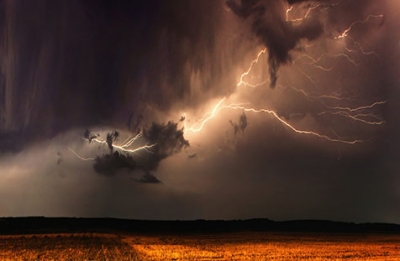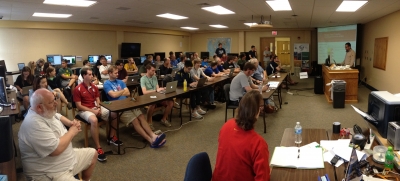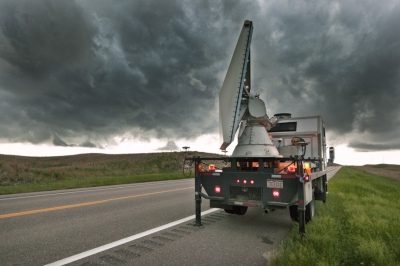Life in the PECAN Operations Center
Published: 12 June 2015
Editor’s Note: Dave Turner, remote sensing expert and lead principal investigator of the ARM funded support for the Plains Elevated Convection at Night (PECAN) field campaign, sent this update.

I have spent the first week of PECAN in the operations center serving as the coordinator of the fleet of mobile vehicles that provide remotely sensed profiles of temperature, humidity, and winds. Here is an excerpt of a typical day’s work… To set the stage: PECAN has four different but related scientific foci, and each of these foci will help us better understand nighttime convective storms over the central plains. The observational resources of the PECAN experiment will study these areas:
- low-level jet streams
- mesoscale convective systems
- elevated convection initiation, and
- bores (colliding masses of air at different temperatures, which are ripples in the atmosphere about half a mile above the surface).
The issue is, only one of these missions can be conducted per night, and so the PECAN Steering Committee devised a process to determine which mission would be conducted on a given night.
It all starts with the forecast
A talented team of forecasters, led by Bill Gallus, includes several students from various universities. The team spends hours reviewing the synoptic conditions, looking at output from numerical weather prediction models, and using their training and intuition to anticipate what Mother Nature may serve up over the PECAN domain that night. They present these results in a 30-minute session daily at 3 p.m. The room is always packed with dozens of senior scientists, students, and coordinators; all ready for the skinny on what may happen that evening.

Immediately after the forecast, Dave Parsons, the chair of the Mission Selection Team (MST), allows a few questions to the lead forecaster (mainly to clarify any points). At this stage, the MST, which includes the chair, the lead scientists for each of the four missions, and the coordinators of the mobile resources adjourn to a separate room to decide on which mission will be conducted that evening. Of course, one possibility is that no mission is conducted because the weather may not be cooperating! This small subset of scientists is under the pressure of the moment: decide what mission will be conducted tonight, where it might be conducted and when, and then get the information out from this meeting to the leads of each of the mobile facilities. I think a social scientist would find this all fascinating, as there are a range of personalities negotiating and dickering about different missions and the likelihood of success, but the clock is running because the mobile teams need time to get their instructions in order to get to their designated deployment locations in time. Ultimately, the chair may need to force a decision, but that hasn’t happened yet—the MST group has always come to a consensus on the mission that we should conduct. The lead scientist for the selected mission now becomes the “boss” and is in charge of conducting that night’s activities.
Mission ready
When a mission has been decided, rough location is picked, and the nominal start time is been selected. There are three people serving as coordinators for the mobile fleet (a ground-based weather station mounted on the top of a minivan), each with different responsibilities. These coordinators immediately let their teams know where they need to go initially and when they need to get there (e.g., go to Smith Center by 6:30 p.m. and wait for instructions). With a fleet of over 20 vehicles, this takes time! It can be very chaotic, because if the fleet has to go a long way, then we need to get the message to the leads of each vehicle quickly.

While the mobile fleet is in transit, the hard part begins. First, the weather continues to evolve, so the mission scientist works with the real-time forecasters (second shift forecasters, as the first shift now are off shift to eat and sleep) to monitor the weather, and to identify exactly where to deploy all of the instruments. The coordinators in the ops center use a range of tools to identify likely good sites, and these coordinates are sent to the mobile teams. Many of the slower driving radar and profiling vehicles have more nimble scout vehicles assigned to them, and these scouts scoot ahead to get “eyeballs on target.” Many times, the site is inadequate and other possible locations need to be found. As we are trying to maintain a particular formation (spatial distribution) of the mobile vehicles that was specified by the mission scientist, the inadequacy of a single site can force the entire formation to be moved! Once the site is located, the radars and profilers start setting up to collect scientific data. This typically takes between 20-30 minutes. Each facility sends back frequent status updates on their activities, and receives additional instructions from the ops center on the types of scans to perform, when to launch weather balloons, and more are sent back and forth. Organization and communication skills are absolutely the skill of the day to make it in the ops center! It’s a complicated dance!
Times a tickin’
We are trying to target active weather events, as we need to understand them better. But, sometimes these convective storms can suddenly become severe weather storms. The coordinators in the ops center, together with the real-time forecasters and mission scientist, are ultimately responsible for the safety of the mobile crews, and need to work closely with the leads of each of those crews. Communication is absolutely critical (didn’t I already say that? I will say it over and over). But, in some rural areas of Kansas, the cell phone network isn’t robust, and thus we use a wide range of technologies (cell phone, text, email, chat spaces, and satellite) to keep in contact with each other as the mission evolves. The mission is progressing, and already we are considering the weather for tomorrow night. This is important because we may want to stage the mobile fleet in some portion of the domain after tonight’s experiment so that there is less driving. For example, if we are north of Salina tonight, we wouldn’t want to drive back to our home base in Hays if we think that we might operate north of Salina again tomorrow! The decision on where to have the mobile crews spend the night has its own set of challenges, because (a) the 24-hour forecast is more uncertain than a 6-hour forecast, and (b) the decision on which mission will be conducted tomorrow won’t officially be made until after tomorrow’s 3 p.m. weather discussion. So the mobile coordinators need to perform some sort of risk-benefit analysis, as they are ultimately trying to keep their crews safe (tired crews make for accidents) and conduct the best science possible.
Mission complete…for the day
Eventually, the mission scientist (often after discussions with the real-time forecasters and the coordinators of the mobile fleet) calls an end to the mission. This is often after 1 am, and can be as late as 5 a.m. The coordinators have to get this information out, and get the rolling fleet to their overnight base. For safety, the coordinators do not leave the ops center until their crews are safely at their overnight location, which can be up to 3 hours after the end of the mission. This means that the coordinators and mission scientist have been hard at work for well over 16 hours on a typical day, from the first forecast discussion until the crews are home. Whew! Now it is time for us to sleep too, as tomorrow will get here soon…
The ARM Climate Research Facility is a DOE Office of Science user facility. The ARM Facility is operated by nine DOE national laboratories, including .
Keep up with the Atmospheric Observer
Updates on ARM news, events, and opportunities delivered to your inbox
ARM User Profile
ARM welcomes users from all institutions and nations. A free ARM user account is needed to access ARM data.


















